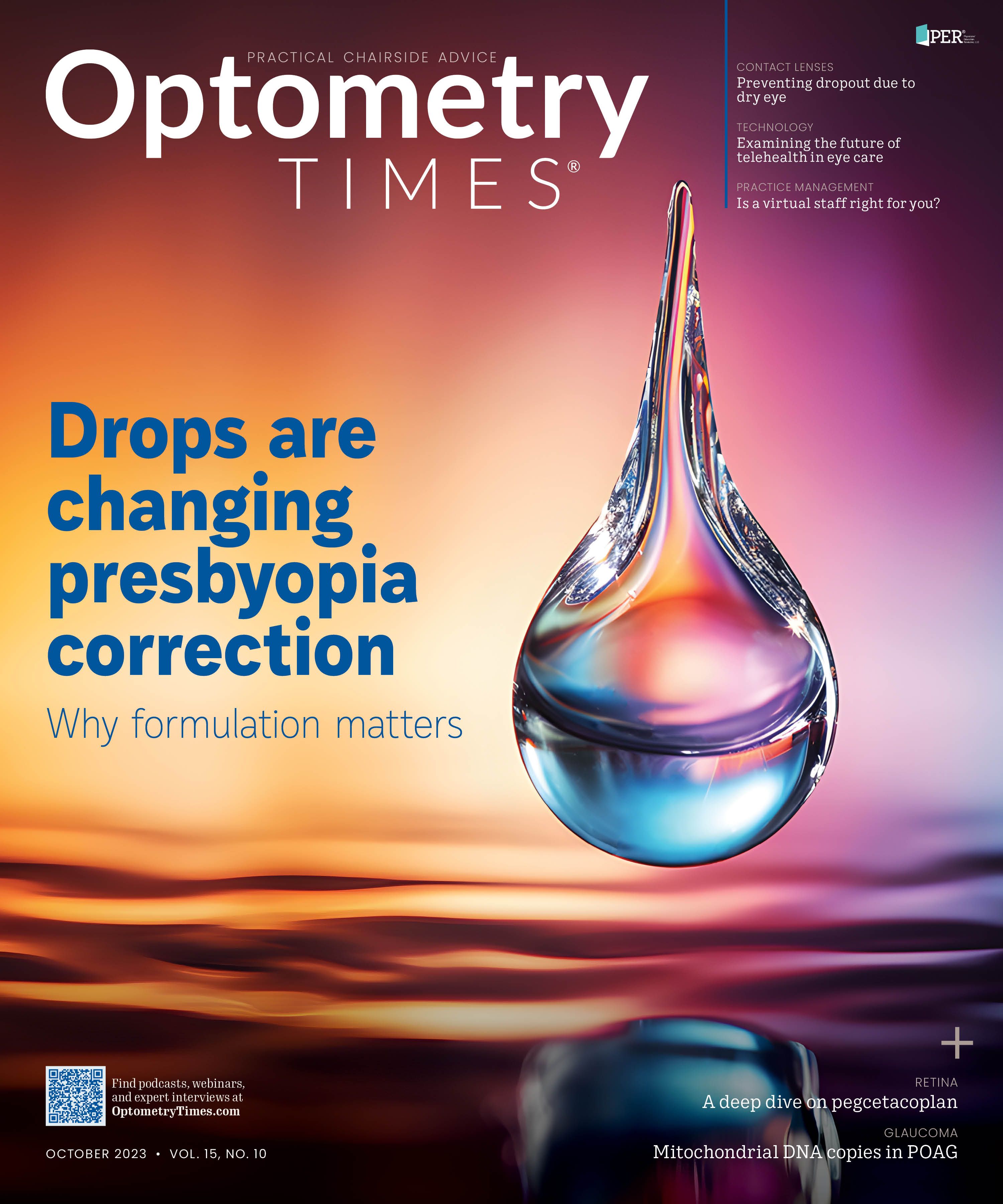Embarking on the quest for comfortable presbyopia correction
Innovations in multifocal contact lenses have expanded options.
When selecting the most appropriate lens for a patient, I do my best to understand their daily routine. It is helpful to know if a patient spends hours on a digital device every day or if they are working in a context that requires frequent use of distance vision. (Adobe Stock / Rido)

In addition to needing vision correction, patients with presbyopia may be facing age-related changes that can affect the ocular surface. Aging can alter the normal processes of the lacrimal functional unit, which includes the lacrimal glands, meibomian glands, ocular surface, and the nerves that connect them.1
Degeneration of 1 or more components of the lacrimal functional unit can lead to tear dysfunction, which is more common with aging. Ocular surface homeostasis also can be compromised with age-related changes, such as atrophy of lacrimal ducts, decrease in lacrimal secretions, thinning of the lipid layer,2 and a higher rate of tear film evaporation.3 Changes to the eyelid may also occur with age, including increased eyelid laxity and atrophy of meibomian glands.1
In addition, demanding lifestyles and the frequent use of digital devices may play a role in the ocular needs of patients with presbyopia. Data suggest that individuals spend an average of 9 or more hours on digital devices every day.4 This can lead to digital eye strain, defined as the development or exacerbation of recurrent ocular symptoms and/or signs related specifically to digital device screen viewing.5 Symptoms may include ocular tiredness, blurred vision, eye strain, pain, burning, dryness, and light sensitivity.5 Digital eye strain is nearly ubiquitous, with a reported prevalence of up to 97%.5 The symptoms of digital eye strain may contribute to the accommodative loss associated with presbyopia.6
Many patients with presbyopia seek vision correction that allows them to continue their demanding lifestyles while maintaining comfortable vision throughout the day. Since soft multifocal contact lenses first became available in the 1980s,7 many innovations in designs and modalities have emerged. Technologies in today’s lenses may offer an enhanced experience for new and experienced wearers alike.
Types of soft multifocal contact lenses
Soft multifocal contact lenses provide 2 or more zones of different refractive power,8 and they provide refractive correction through alternating or simultaneous images.
Lenses with alternating images depend on the movement of the lens on the surface of the eye for vision through the different zones of refraction.8 They are designed to deliver distance refraction when looking up or ahead, and the lenses move up to position the near power when patients look down.9
Simultaneous image lens designs position the distance and near refractive powers within the pupillary area for all gaze positions.10The retina receives light from different targets and translates images in focus and out of focus. Thus, neural adaptation is required to select the sharper image. Pupil size, among many other factors, is important for visual performance in these lens types.8 Most multifocal lenses available today offer a simultaneous image design.11
The 2 main types of simultaneous image contact lens designs are concentric multifocal contact lenses and aspheric multifocal contact lenses. Concentric designs have either distance or near power in the center of the lens, with concentric rings of either near or distance power. Aspheric designs feature a gradual transition in lens power, from the center to the periphery of the lens, beginning with either center-near or center-distance and changing radially across the lens.8 Some lenses may include both concentric and aspheric lens designs.11
Modern designs for a modern world
Multifocal lenses come in different replacement frequencies and incorporate a variety of technologies to improve the experience for wearers.
A monthly replacement lens (BiofinityÒ multifocal; CooperVision) has a center-distance lens that is placed over the dominant eye and a center-near lens that is placed over the non-dominant eye.11 The Bausch + Lomb ULTRAÒfor Presbyopia is another monthly replacement lens utilizing a center-near, 3-Zone ProgressiveÔ design that is optimized for 7 biometrics, including pupil size, across 9 critical distances.12 Among the biweekly replacement lenses, the ACUVUEÒ Oasys for Presbyopia by Johnson & Johnson comes in a center-distance design with concentric, aspheric rings correcting for near and intermediate vision.11 The ACUVUE Oasys Multifocal has a pupil-optimized design that tailors 100% of its parameters to pupil size variations.13
Daily replacement multifocal lens options include the BiotrueÒ OneDay for Presbyopia by Bausch + Lomb, the DAILIES TOTAL1Ô Multifocal by Alcon, the MyDayÒ Multifocal by CooperVision, and the ACUVUE Oasys MAX 1-Day Multifocal. The Biotrue OneDay for Presbyopia features the same center-near, 3-Zone Progressive design that is in the ULTRAfor Presbyopia lens, providing seamless transitions between distances.14 The Biotrue OneDay for Presbyopia lenses maintain approximately 100% of their moisture for 16 hours of wear.15 The DAILIES TOTAL1Ô Multifocal features a center-near, biaspheric design and incorporates water gradient technology, which places water at the outermost surface of the lens.16 The MyDay Multifocal has a Binocular Progressive SystemÔ design and AquaFormÒ Technology, making them comfortable to wear all day.17 The ACUVUE Oasys MAX 1-Day Multifocal has the same pupil optimized design as the ACUVUE Oasys Multifocal. It also has TearStable TechnologyÔ, which optimizes wetting agent distribution throughout the lens on the surface.18
The latest entrant to the market is Bausch + Lomb’s INFUSEÒ Multifocal, which incorporates the same 3-Zone Progressive design used in other Bausch + Lomb Multifocal lenses as well as the INFUSE material technologies: the silicone hydrogel kalifilcon A and ProBalance TechnologyÒ, which incorporate osmoprotectants, electrolytes, and moisturizers into the lens to help maintain ocular surface homeostasis.19
Patient factors that influence selection
When selecting the most appropriate lens for a patient, I do my best to understand their daily routine. It is helpful to know if a patient spends hours on a digital device every day or if they are working in a context that requires frequent use of distance vision.
It is also valuable to ask patients about their hobbies and how they typically spend their free time. Patients who spend a good portion of their time on digital devices for work or leisure may benefit from a lens that gives reliable comfort while using digital devices. Patients who wear their lenses from morning until bedtime will probably need a lens that offers extended comfort to reduce end-of-day discomfort. Being informed about the daily vision needs of my patients can help me narrow down the options between the various designs and technologies available.

As eye care professionals, our armamentarium for patients with presbyopia is growing. There are now many contact lenses to choose from that can offer the comfortable and convenient experience our patients are looking for. Although it may require some time initially to learn about a patient’s needs, knowing we are offering the most advanced designs and seeing our patients satisfied in their lenses makes the process worth it.
References
Lafosse E, Wolffsohn JS, Talens-Estarelles C, García-Lázaro S. Presbyopia and the aging eye: existing refractive approaches and their potential impact on dry eye signs and symptoms. Cont Lens Anterior Eye. 2020;43(2):103-114. doi:10.1016/j.clae.2019.08.005
Maïssa C, Guillon M. Tear film dynamics and lipid layer characteristics—effect of age and gender. Cont Lens Anterior Eye. 2010;33(4):176-182. doi:10.1016/j.clae.2010.02.003
Guillon M, Maïssa C. Tear film evaporation—effect of age and gender. Cont Lens Anterior Eye. 2010;33(4):171-175. doi:10.1016/j.clae.2010.03.002
Hindsight is 20/20/20: protect your eyes from digital devices. The Vision Council. 2015. Accessed May 30, 2023. https://www.michianaeye.com/storage/app/media/VC_DigitalEyeStrain_Report2015.pdf
Wolffsohn JS, Lingham G, Downie LE, et al. TFOS lifestyle: impact of the digital environment on the ocular surface. Ocul Surf. 2023;28:213-252. doi:10.1016/j.jtos.2023.04.004
Kaur K, Gurnani B, Nayak S, et al. Digital eye strain-a comprehensive review. Ophthalmol Ther. 2022;11(5):1655-1680. doi:10.1007/s40123-022-00540-9
Grant NJ, Fujimoto MJ, Caroline PJ, Norman CW. History of contact lenses. Contact Lens Spectrum. November 1, 2021. Accessed May 11, 2023. https://www.clspectrum.com/supplements/2021/november-2021/contact-lens-spectrum-special-edition-2021-celebra/history-of-contact-lenses
Remón L, Pérez-Merino P, Macedo-de-Araújo RJ, Amorim-de-Sousa AI, González-Méijome JM. Bifocal and multifocal contact lenses for presbyopia and myopia control. J Ophthalmol. 2020;2020:8067657. doi:10.1155/2020/8067657
Benoit D. Mastering multifocals. Contact Lens Spectrum. July 1, 2005. Accessed May 11, 2023. https://www.clspectrum.com/issues/2005/july-2005/mastering-multifocals
Pérez-Prados R, Piñero DP, Pérez-Cambrodí RJ, Madrid-Costa D. Soft multifocal simultaneous image contact lenses: a review. Clin Exp Optom. 2017;100(2):107-127. doi:10.1111/cxo.12488
Ritter, C. A guide to multifocal contact lenses. Eyes on Eyecare. July 10, 2019. Accessed May 11, 2023. https://eyesoneyecare.com/resources/a-guide-to-multifocal-contact-lenses/
ULTRA for Presbyopia Monthly. Bausch + Lomb 2023. Accessed May 17, 2023. https://ecp.bauschcontactlenses.com/products/ultra-monthly/presbyopia
ACUVUE Multifocal Contact Lenses with pupil optimized design. Johnson & Johnson Vision Care. 2023. Accessed May 17, 2023.https://www.jnjvisionpro.com/products/acuvue-multifocal
Biotrue ONEday. Bausch + Lomb. 2023. Accessed May 11, 2023. https://www.biotrueonedaylenses.com/about-us/
Biotrue ONEday. Bausch + Lomb. 2023. Accessed May 17, 2023. https://ecp.bauschcontactlenses.com/products/biotrue-oneday
Total1 Multifocal. Alcon. 2023. Accessed May 11, 2023. https://total.myalcon.com/au/products/dailies-total-1-multifocal/
MyDay Multifocal. CooperVision. 2023. Accessed May 11, 2023. https://coopervision.com/practitioner/our-products/myday-family/myday-multifocal
ACUVUE Oasys Max 1-Day Multifocal. Johnson & Johnson Vision Care 2023. Accessed May 17, 2023. https://www.jnjvisionpro.com/products/acuvue-oasys-max-1-day-multifocal
INFUSE Multifocal. Bausch + Lomb. 2023. Accessed May 24, 2023. https://ecp.bauschcontactlenses.com/products/infuse-one-day/multifocal

Newsletter
Want more insights like this? Subscribe to Optometry Times and get clinical pearls and practice tips delivered straight to your inbox.